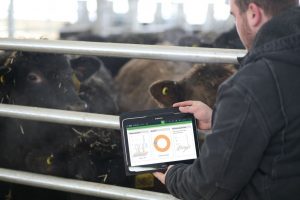AgSights was one of the earliest companies in Ontario to collect phenotypic data on beef cattle, starting in 1993, thanks to a provincially-funded program to support the beef industry. When that funding stopped, the enormous database was a valuable starting point to develop solutions focused on traceability.
AgSights’ original farm management software has been upgraded and renamed Go360|bioTrack. Originally, it focused heavily on genetics; today the emphasis of Go360|bioTrack is on helping producers evolve their business and management style to take advantage of ALL the data they collect. It features a chute-side application to capture data in real time that fits into existing tagging methods and an interface in a grid format that allows for instant, easy comparisons and effective decision-making.

AgSights’ bioLinks solution, on the other hand, is designed for small-to-medium-sized processing plants. “We bought a food inventory tracking and sales program that Alberta Agriculture (as it was known then) developed,” says Betty-Jo Almond, AgSights’ General Manager. “We added a production piece that connected the source farm and RFID of animals to follow each animal and meat cut using a bar code to the individual consumer. So today, we can connect the data across the whole value chain. We also offer weekly genetic evaluations through Go360|bioTrack. As we continue to evolve, it would be great to incorporate data from both softwares into the evaluation process.”
Also using RFID tags/technology, bioLinks follows animals from the farm to the processing plant—and then each cut from inventory to individual purchases. And that part is the clincher. By directly reaching the ear of the consumer and supporting feedback through a QR code, producers and processors can learn about the consumer experience when eating the product.
“Consumers like to give feedback,” explains Betty-Jo. “It’s empowering. Just look at the way product is promoted and labelled in your grocery store. They want to know more about the food they’re eating. We just haven’t enabled this to benefit consumers or the livestock industry.”
bioLinks provides the opportunity to build the story of the product and brand it. In a chain grocery store, for example, since each meat cut gets its own unique ID, it is possible to bring up a quick webpage of key marketing information on the consumer’s mobile device. This might include: what farm the animal was raised on (and therefore, whether it is locally-sourced); whether the animal was sustainably produced without hormones; whether it was corn-fed or grass-fed. Should there ever be a recall on the product, the traceability is bullet-proof—both backwards to the carcass and the farm and forwards to the consumer’s fridge—and that minimizes any potential impact. Producers and processors can evolve their businesses to satisfy consumer demands, and consumers get the source information they’ve been asking for. Win-win!

“Cory Van Groningen from VG Meats is one of our Board members. He uses bioLinks. And another, Mike Buis, is a supplier” says Betty-Jo. “So we have first-hand feedback on the endless potential when you start connecting the data from farm to fork. VG Meats is a great example. They want to buy more animals within a range of 5-13 mm backfat, and they test for tenderness because that’s how their consumers select meat for their dinner table. Not enough cross-linkages like that are happening across the industry.”
But, before data can be applied… we need the research! That’s where Gentec comes in. Gentec CEO Graham Plastow has been a member of the AgSights board since 2013, and AgSights was a partner on Gentec’s Canadian Cattle Genome Project (led by Steve Moore, Steve Miller and Paul Stothard) funded by a Genome Canada project and its Genome Alberta-funded successor project on feed efficiency (led by John Basarab, now at Gentec).
“Different technologies can play a role, depending on the question being asked,” says Plastow. “However, DNA is the ‘passport’ providing the basis to add information, such as that provided by AgSights. Collecting data throughout the chain allows us to identify tools to help improve product attributes. The QR code allows the consumer to ask those questions, indicate what is important to each of them—and get the answers”
